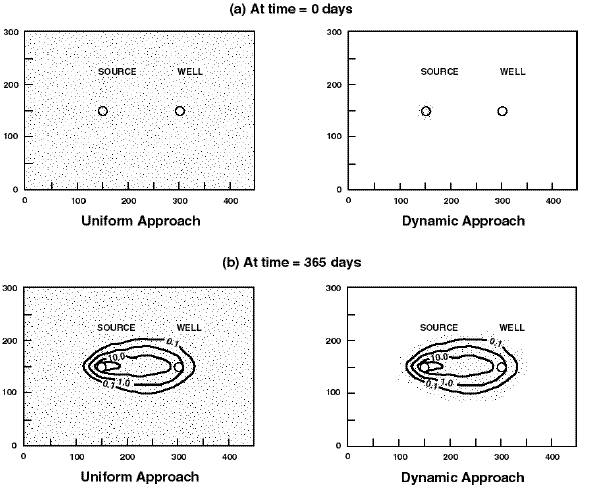Rather than placing many packets in every cell, MT3D can be directed to allocate packets dynamically so they are placed where they are needed to represent contaminant and not where the concentration is zero (or very low).
- At first, if the system is full of clean, or background
concentration, water little or no packets are needed.
As particles leave source cells more packets need to be added
As particles accumulate at sink cells packets need to be removed
At other cells, packets need to be added or deleted as the concentration gradient changes, particularly more packets are required at the front of the plume
- CMAXi,j,k - maximum concentration
near the cell
- CMINi,j,k - minimum concentration near the
cell
- CMAX - maximum concentration in the entire grid
- CMIN - minimum concentration in the entire grid

- CMAX - maximum concentration in the entire grid
The modeler also defines a critical value of DCCELL called DCEPS at which the high or low number of cells will be allocated.
- for:
- DCCELL < DCEPS fewer packets
are used (NPL packets)
- DCCELL > DCEPS more packets are used (NPH packets)
- DCCELL > DCEPS more packets are used (NPH packets)
When the # of packets in a cell is less than NPMIN new packets equal to NPL or NPH are added
Existing packets are not changed
When the # of packets in a cell is greater than NPMAX all packets are removed from the cell and replaced by a new set of NPH packets , maintaining mass balance in the cell
The packet distribution ends up changing, for example as shown below:

A fixed or random distribution of packets in a cell can be selected. A fixed distribution works better in uniform flow fields and a random distribution works better in heterogeneous media
Packets are assigned the concentration of the cell in which they are added
FOR MMOC - DCCELL < DCEPS fewer packets
are used (NPL packets)
- sink cells receive multiple packets based
on above criteria, because addition of one packet at a sink cell is likely
to result in zero velocity due to symmetry of convergent flow on the sink
The concentration is then the weighted average of the packet concentrations
source cell packets will converge on the node so Cn* tends toward Cn